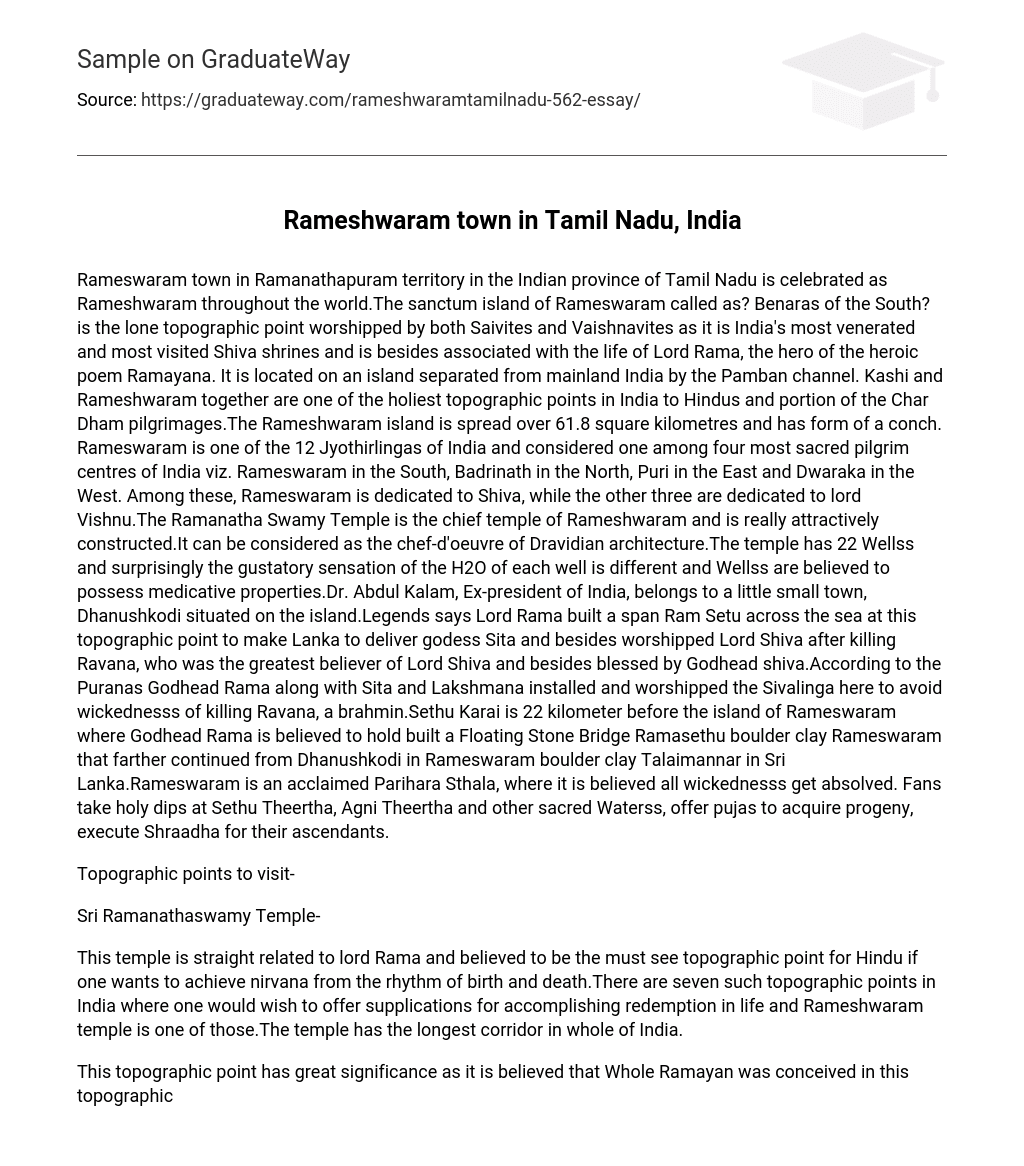Rameswaram town, in the Ramanathapuram district of the Indian state of Tamil Nadu, is celebrated as Rameshwaram throughout the world. The sanctum island of Rameswaram, called the “Benaras of the South,” is the only place worshipped by both Saivites and Vaishnavites, as it is India’s most venerated and most visited Shiva shrine and is also associated with the life of Lord Rama, the hero of the epic Ramayana.
It is located on an island separated from mainland India by the Pamban channel. Kashi and Rameshwaram together are among the holiest places in India for Hindus and are part of the Char Dham pilgrimages. The Rameshwaram island is spread over 61.8 square kilometers and has the shape of a conch. Rameswaram is one of the 12 Jyotirlingas of India and is considered one of the four most sacred pilgrim centers of India, along with Badrinath in the North, Puri in the East, and Dwaraka in the West. Among these, Rameswaram is dedicated to Shiva, while the other three are dedicated to Lord Vishnu.
The Ramanatha Swamy Temple is the chief temple of Rameshwaram and is very beautifully constructed. It can be considered the masterpiece of Dravidian architecture. The temple has 22 wells, and surprisingly, the taste of the water of each well is different. The wells are believed to possess medicinal properties.
Dr. Abdul Kalam, Ex-president of India, belongs to a small village, Dhanushkodi, situated on the island. Legends say that Lord Rama built a bridge, Ram Setu, across the sea at this point to reach Lanka to rescue goddess Sita and also worshipped Lord Shiva after killing Ravana, who was the greatest believer of Lord Shiva and also blessed by Lord Shiva.
According to the Puranas, Lord Rama, along with Sita and Lakshmana, installed and worshipped the Sivalinga here to avoid the sins of killing Ravana, a Brahmin. Sethu Karai is 22 kilometers before the island of Rameswaram, where Lord Rama is believed to have built a Floating Stone Bridge, Ramasethu, from Rameswaram to Talaimannar in Sri Lanka. Rameswaram is an acclaimed Parihara Sthala, where it is believed that all sins are absolved. Devotees take holy dips at Sethu Theertha, Agni Theertha, and other sacred waters and offer pujas to get progeny and perform Shraadha for their ancestors.
Places to visit:
Sri Ramanathaswamy Temple: This temple is directly related to Lord Rama and is believed to be a must-visit place for Hindus who want to achieve nirvana from the cycle of birth and death. There are seven such places in India where one would like to offer prayers for achieving redemption in life, and Rameshwaram temple is one of them. The temple has the longest corridor in the whole of India. This place has great significance as it is believed that the whole Ramayana was conceived here.
Gandhamadhana Parvatham: Gandhamadhana is the most celebrated and worshipped in southern India, with Lord Rama’s feet imprinted on the chakra placed in the temple. Gandhamadhana is the deity of several communities in southern India. It is a holy place thronged by devotees from all parts of India. It has Rama tirtham constructed on the Gandamadhana Parvata, hence, on Thursday it is called Gandamadana.It is close Dhanushkodi, where Rama met Vibhishana and has its ain historical importance.
Agnitheertham: It is one of the 12 jyotirlings of India and is one of the holiest topographic point to visit.It has a big lake whose H2O is considered holy and people believes that taking bath in the topographic point washes away their wickednesss and one attains salvation.It has 22 Wellss holding Waterss of different gustatory sensation. It is one visit topographic point.
Badrakaliamman Temple: It is the largest temple of Ma Kali in southern India, who is the sanctum female parent for devotees in southern India. The statue of Maa Kali is of pure gold, and the temple has different masterpieces from different ages.
Annai Indira Gandhi Road Bridge: It is the longest span in southern India, linking Rameswaram Island to the mainland. It is also called the Pambam Bridge as it is located beside Pamban, the sacred place where Rama could slake the thirst of Sita by throwing an arrow in the place where they could really recover cool water. It is 7 km long.
Other temples: There are numerous other temples holding religious as well as historical significance. Villondi Tirtham is one of those temples located on a point where Lord Rama buried his bow as ‘Villondi’ means a buried bow. It is about 7 kilometers from the main Rameshwar temple and is considered to be a sacred place by most of the followers. It has a place where drinking water is available in the midst of salty sea.
Dhanushkodi Temple is another chief temple on the southern tip of India located near the Bay of Bengal and Indian Ocean on the other side. The seas are in the form of bow and arrow when viewed from the top. Lord Rama has his pious feet even in this temple, and the whole narrative of Ramayana revolves around this temple as well.
Five faceted Hanuman temple is another celebrated temple. The statues of Lord Rama, Laxman, Sita, and Hanuman are placed in the temple. The temple has a drifting rock which was believed to be used to build the span on the sea. Nambu Nayagiamman Temple is another deserving visiting temple.
How to reach – By Air: The nearest airport is Madurai, which is 163 kilometers from Rameshwaram and has good road connectivity to it.
By Train: The railroad connects Rameshwaram to places like Chennai, Madurai, Coimbatore, Trichy, and Thanjavur, and the 2-kilometer-long Indira Gandhi Bridge connects the island of Rameshwaram with the mainland of Mandapam.
By Road: Rameshwaram is well connected by roads to all the major cities nearby, Kanyakumari, Trichy, Pondicherry, Tanjore, and Chennai.





